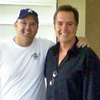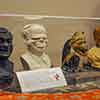BACKSTORY: The Walt Disney Studios in Burbank, California are the international headquarters for The Walt Disney Company. Construction began in February 1939 with Frank Crowhurst acting as Chief Contractor and Disney Legend Bill Garity as supervisor. The Disney staff began to move from the old Disney studio at Hyperion Avenue in Silver Lake on December 24, 1939. Designed primarily by Kem (his name was formed with the intials of his full name: Karl Emanuel Martin) Weber under the supervision of Walt and his brother Roy, the Burbank Disney Studio buildings are the only studios to survive from the Golden Age of filming and the only major film studio not to run backlot tours. Kem Weber was an art director for Barker Bros. Furniture in Los Angeles, and he also designed modern film sets and private residences. The Studio is situated on approximately 51 acres of land.
The Walt Disney Studios was originally designed around the animation process, with the large animation building in the center of the campus and adjacent buildings for the story department, the music department, the ink-and-paint departments, and the other various functions of the studio. The Disney feature “The Reluctant Dragon” (1941), starring Robert Benchley, served as a tour of the then-new studio, which was also frequently seen and toured on the various Walt Disney television programs. The Water Tower once held 150,000 gallons of water and was built at a cost of $300,000; most have 4 support legs, but Roy Disney specifically requested 6 for this 135.5' tall structure.
In the late 1940s, the studio began regular work on live-action features. Lacking the money to do it themselves, Jack Webb offered to put up some of the money to build live-action stages in exchange for their use. Webb used it to shoot much of the Dragnet TV series. During this time, back lots were also built and remained standing at the studios until the management change of the mid-1980s. Soundstage 1 is where the live action footage for “Fantasia” was filmed; soundstage 2 is where “The Mickey Mouse Club,” “Mary Poppins,” and “Pirates of the Caribbean” was shot.
In 1986, after the corporate restructuring of Walt Disney Productions into The Walt Disney Company, the buildings were remodeled to accommodate more live-action production space and administrative offices. The Studios are now made up of multiple office and administration buildings and ten soundstages. The primary building is the Team Disney Burbank building, completed in 1990 and designed by Michael Graves. The Team Disney Burbank building contains the office of President and CEO Robert A. Iger, as well as the boardroom for the Board of Directors. The building is sometimes called the “Seven Dwarfs Building” because of its seven dwarfs statues holding up the roof of the building.
On January 23, 2006, in honor of Michael Eisner's 21-year leadership of the company, the Team Disney building, was rededicated as Team Disney - The Michael D. Eisner Building. During the restructuring, the animation facilities were spun off to officially create Walt Disney Feature Animation as a subsidiary of the company, and its operations were moved to the Air Way warehouse in Glendale. In 1995, a new Feature Animation building was completed, across the street from the main lot. The new studio is a colorful piece of architecture, adorned by a giant Sorcerer’s Hat, which once housed of the office of Roy E. Disney, former head of WDFA.
More recently, after Disney's purchase of ABC, a new headquarters for the television network was constructed across Riverside Drive next to the Feature Animation Building. The ABC building was designed by Aldo Rossi and is connected to the lot by a blue serpentine bridge that crosses over Riverside Drive. The ABC building also houses the offices of other subsidiaries such as ABC Studios and Buena Vista International.
 On a recent studio tour, the guide mentioned that Shaun Cassidy now occupies Walt’s old office. Shaun Cassidy? Seemed a little odd, but Daveland reader Maverick pulled through on this one! Here is his personal story:
On a recent studio tour, the guide mentioned that Shaun Cassidy now occupies Walt’s old office. Shaun Cassidy? Seemed a little odd, but Daveland reader Maverick pulled through on this one! Here is his personal story:
“While I was visiting a friend of mine who works at Hollywood Records, we heard from a page that for some reason, Walt Disney's old office was actually unlocked and no one was around. So we ran up there, and sure enough, we got in with no one to stop us. It was completely empty, with a coat of fresh new paint. It looked like someone was going to be moving into the office. So I started taking photos with my cell phone when I heard a voice from behind me. "Hi, how are ya?" I turned around, and it was Shaun Cassidy.
"Oh hi, Shaun! I'm Maverick from LIVE 1055 in Ventura (a radio station I was programming at the time)." "Great, nice to meet you," Shaun said as he shook my hand. "I'm a huge Disney fan, so I was just taking photos. What brings you here?" "Oh...this is my new office."
Apparently Shaun Cassidy has a production company at the Walt Disney studios, and needed a bigger place. When the studio said, "Well the only available office we have big enough for you is Walt's old office," Shaun thought, no way…this should be a museum! The studio said, take it or leave it. So Cassidy took it. He told me that one wall would be devoted to old photos of Walt in the office. We talked for a while and he even invited me back when the office was finished. Finally I asked if I could get a photo of the two of us together. He was kind enough to do so, and we were on our way.”
Thanks for sharing, Maverick! Follow Maverick's latest exploits on Twitter.
 In 1949, a mechanical bird in a New Orleans antiques shop sparked Walt Disney's imagination to create 3D animated figures. More than a dozen years later, Disney artists and engineers perfected Audio-Animatronics technology. Disney put artist Ken Anderson in charge of developing the very first prototype for the new medium, a 3D dancing man. Actor Buddy Ebsen agreed to model for the part, and danced on film so that artists and technicains could study every movement. Anderson's design called for a miniature stage built on top of a series of hand-cut metal cams that prompted the dancer's movements. Walt himself did most of the construction for the display including attempting to carve the 9" Ebsen look-alike, but he quickly gave up and rlied on the talents of a sculptor. Disney employed a movie projector to turn the cams, as well as provide the sound track synchronized to the dancing man's movements. Although the dancing man never had a public audience, the very first Audio-Animatronics figured paved the way for the development of a revolutionary technology that would eventually become a hallmark feature of many of Disney's theme park attractions. In 1963, the public saw this new art form for the first time in Disneyland's Enchanted Tiki Room, featuring 225 singing and joke-telling birds, flowers, and tiki gods.
In 1949, a mechanical bird in a New Orleans antiques shop sparked Walt Disney's imagination to create 3D animated figures. More than a dozen years later, Disney artists and engineers perfected Audio-Animatronics technology. Disney put artist Ken Anderson in charge of developing the very first prototype for the new medium, a 3D dancing man. Actor Buddy Ebsen agreed to model for the part, and danced on film so that artists and technicains could study every movement. Anderson's design called for a miniature stage built on top of a series of hand-cut metal cams that prompted the dancer's movements. Walt himself did most of the construction for the display including attempting to carve the 9" Ebsen look-alike, but he quickly gave up and rlied on the talents of a sculptor. Disney employed a movie projector to turn the cams, as well as provide the sound track synchronized to the dancing man's movements. Although the dancing man never had a public audience, the very first Audio-Animatronics figured paved the way for the development of a revolutionary technology that would eventually become a hallmark feature of many of Disney's theme park attractions. In 1963, the public saw this new art form for the first time in Disneyland's Enchanted Tiki Room, featuring 225 singing and joke-telling birds, flowers, and tiki gods.
Visit my blog for an account of the evening’s festivities!